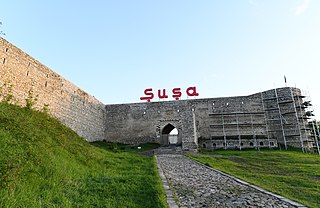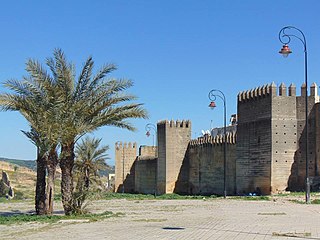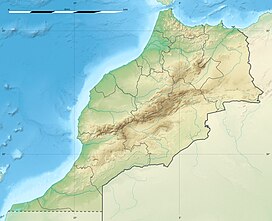
The Atlas Mountains are a mountain range in the Maghreb in North Africa. It separates the Sahara Desert from the Mediterranean Sea and the Atlantic Ocean; the name "Atlantic" is derived from the mountain range. It stretches around 2,500 km (1,600 mi) through Morocco, Algeria and Tunisia. The range's highest peak is Toubkal, which is in central Morocco, with an elevation of 4,167 metres (13,671 ft). The Atlas mountains are primarily inhabited by Berber populations. The terms for 'mountain' are Adrar and adras in some Berber languages, and these terms are believed to be cognates of the toponym Atlas. The mountains are also home to a number of animals and plants which are mostly found within Africa but some of which can be found in Europe. Many of these species are endangered and a few are already extinct. The weather is cooling but has sunny summers, and the average temperature there is 25°C.

The Siegfried Line, known in German as the Westwall, was a German defensive line built during the 1930s opposite the French Maginot Line. It stretched more than 630 km (390 mi); from Kleve on the border with the Netherlands, along the western border of Nazi Germany, to the town of Weil am Rhein on the border with Switzerland – and featured more than 18,000 bunkers, tunnels and tank traps.

El Jadida is a major port city on the Atlantic coast of Morocco, located 96 km south of the city of Casablanca, in the province of El Jadida and the region of Casablanca-Settat. It has a population of 170,956 as of 2022.

A Hakka walled village is a large multi-family communal living structure that is designed to be easily defensible. This building style is unique to the Hakka people found in southern China. Walled villages are typically designed for defensive purposes and consist of one entrance and no windows at the ground level.

Sijilmasa was a medieval Moroccan city and trade entrepôt at the northern edge of the Sahara in Morocco. The ruins of the town extend for five miles along the River Ziz in the Tafilalt oasis near the town of Rissani. The town's history was marked by several successive invasions by Berber dynasties. Up until the 14th century, as the northern terminus for the western trans-Sahara trade route, it was one of the most important trade centres in the Maghreb during the Middle Ages.

Spanning over three thousand years, ancient Egypt was not one stable civilization but in constant change and upheaval, commonly split into periods by historians. Likewise, ancient Egyptian architecture is not one style, but a set of styles differing over time but with some commonalities.
Abul Amlak Moulay Sharif ibn 'Ali – also known as Moulay Ali al-Sharif or Moulay Mohammed Cherif, Moulay Cherif, Moulay al-Sharif or Muhammad I – was born in 1589 and died June 4, 1659, at Sijilmasa. He was an Arab Emir of Tafilalt from 1631 to 1636. He was a Sharif whose family claimed descent from the Islamic prophet Muhammad through his grandson Hasan. He is considered as the founder of the Alaouite Dynasty of Morocco as he was the father of Sidi Muhammad, Al-Rashid of Morocco and Ismail Ibn Sharif.

Stone walls are a kind of masonry construction that has been used for thousands of years. The first stone walls were constructed by farmers and primitive people by piling loose field stones into a dry stone wall. Later, mortar and plaster were used, especially in the construction of city walls, castles, and other fortifications before and during the Middle Ages. These stone walls are spread throughout the world in different forms. One of the best example is the Cyclopean Wall in Rajgir, India.

The Anti-Atlas, also known as Lesser Atlas or Little Atlas is a mountain range in Morocco, a part of the Atlas Mountains in the northwest of Africa. The Anti-Atlas extends from the Atlantic Ocean in the southwest toward the northeast, to the heights of Ouarzazate and further east to the city of Tafilalt, altogether a distance of approximately 500 km. The range borders on the Sahara to the south.
Viam is a commune in the Corrèze department in central France. The village is positioned on a lake, used for swimming, fishing, water-skiing, canoeing, kayaking, sailing and land activities such as hiking and cycling.

The Castle of Carrazeda de Ansiães, normally shortened to Castle of Ansiães, is a medieval castle in the civil parish of Lavandeira, municipality of Carrazeda de Ansiães of Portugal.

Knin Fortress is located near the tallest mountain in Croatia, Dinara, and near the source of the river Krka. It is the second largest fortress in Croatia and most significant defensive stronghold, and a historical town in the Šibenik-Knin County in the Dalmatian Hinterland. The construction of the fortress started as early as 9th century, while the current state was brought up in 17th and 18th centuries. It reached its peak during the reign of Demetrius Zvonimir, King of Croatia from 1076, as it served as a political center of the Croatian Kingdom under him.

The Shusha fortress or Shushi fortress is a fortress surrounding the historical centre of Shusha, also called Shushi. Newly established castle town was called "Panahabad fortress" named after Panah Ali Khan who was the founder of the fort. In later years, the city was just called "Fortress". The name of Shusha was probably derived from a nearby Armenian village called Shosh or Shushikent.

The Walls of Trabzon are a series of defensive walls surrounding the old town of the city of Trabzon, northeastern Turkey. The fortifications are sometimes called the Trabzon Castle. However, they did not function as a castle, rather as city walls. Constructed on foundations dating back to the Roman era with cut stones from former structures at site, the walls stretch from the hill on the backside of the old town to the Black Sea shore. The walls further divided the city into three parts; the Upper Town or "fortress", the Middle Town and the Lower Town. The upper and middle towns are flanked by steep ravines cut by the Zagnos (Iskeleboz) and Tabakhane (Kuzgun) streams to the west and east respectively, while the lower town extends to the west of Zagnos.

The Fortifications of Fez comprise a complex circuit of ramparts and gates surrounding Fes el-Bali and Fes el-Jdid, two urban agglomerations that compose the old "medina" of Fes, Morocco. They also include a number of kasbahs (citadels) and forts which were built both to protect and to control the city. These fortifications have been built up over many centuries and the extensive remnants today date from many different periods.

The Palace of the Karabakh Khans or the Palace of Panah Ali Khan is a palace located in the historical center of the city of Shusha, the former residence of the founder of the Karabakh Khanate, Panah Ali Khan. During the reign of Panah Ali Khan, the palace was also the residence of the ruler where he lived together with his family. His son, Ibrahimkhalil Khan, together with his family and followers settled in the Palace of Ibrahimkhalil Khan built in the same period. For the eldest son of Ibrahimkhalil Khan, Mukhammedhasan Agha, another palace was built on a sheer cliff in the southeast of the Shusha plateau. In addition to these palaces, the Palace of the Khan's daughter, Natavan, and the Palace of Gara Boyuk khanim, belonging to the Khan's family, were also built in Shusha. Although in various sources the name of the Palace of the Karabakh Khan is attributed to each of these buildings, the main political residence of the Karabakh Khans was the palace-castle of the first Karabakh Khan, Panah Ali Khan.
Tasghîmût is a medieval fortress near Marrakesh, Morocco, built on a rocky plateau and fortified by the Almoravids under Ali ibn Yusuf in the 12th century to protect the nearby capital of Aghmat when the Almohads were making inroads in the western Maghreb. The fortress was conquered by the Almohads in 1132. Some archeological excavations were carried out in the 20th century, but many of the remains of the fortifications have been used for local building projects.

Paul Pascon was a Moroccan sociologist whose multidisciplinary work aimed to elucidate French colonialism in Morocco and the capitalism that accompanied it, and the development of Morocco after its independence from France. He was perhaps the first modern scholar to study Gara Medouar, and he was one of the foremost experts on the Moroccan economy and agriculture and its transformation under colonialism and after independence.

The Skhvilo fortress, also known as Skhvilo castle, is a medieval fortress located in the region of Shida Kartli, in Kaspi District, Georgia. It was built in the 14th century, and served as the first residence of the duke (tavadi) family Amilakhori.

Gara Boyuk Khanim Castle is one of the two Shusha castles that have survived to nowadays. The inscription above the entrance to the castle says that it was built in 1182 AH (1768).























